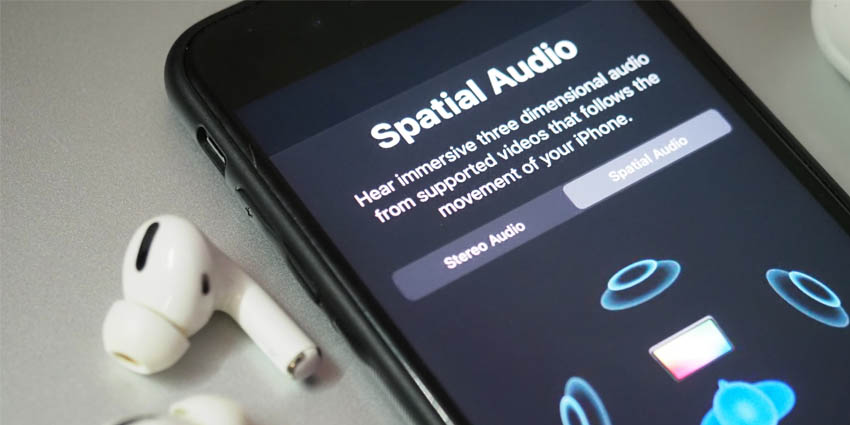Spatial audio can change how we perceive music and more. It creates an immersive experience for listeners by providing spatial context to the audio source.
Immersive environments use 360-degree spaces where users can enjoy 3D content from all directions. Spatial audio enhances interactions in virtual, augmented, and mixed reality (VR/AR/MR) spaces with incredible realism.
This audio format is a massive improvement from mono and stereo sound. It aims to evolve how users interact with music, movies, and the future Metaverse.
How does Spatial Audio Work?
Spatial audio sound systems simulate real-world sound waves with precise realism. People listening to passing cars, conversations, and other location-based applications can leverage immersive spatial audio.
To achieve this, sound engineers reord using binaural setups with two microphones capturing audio at the same time, creating a 3D sound. Binaural recordings replicate how sound waves react to environments.
Additionally, specialised software and devices help sound engineers to capture and reproduce spatial audio with precision and clarity.
Next-Gen Headsets and Spatial Audio
Among a growing list of VR headsets, many people experienced their first encounters with the technology with the Meta Quest 2. Additional headsets, including the Meta Quest Pro, HTC VIVE XR Elite, Pico 4 and Pico 4 Enterprise, Varjo VR-3 and XR-3, and Lenovo VRX and A3 feature this technology.
These devices incorporate spatial audio for collaborative tools, simulations, and gaming to deliver key sound and feedback for users. For example, those using a flight simulator can use 3D sound to locate a fault signal or briefing intercom. Conversely, those attending immersive concerts can enjoy the full presence of 3D orientated music.
Additionally, numerous firms like Agora and Conquest VR are developing third-party solutions to provide enhanced spatial audio experiences. These tools leverage existing device hardware across smartphones, laptops, PCs, tablets, and headsets to recreate immersive audio for listeners.
This comes amid a series of collaborations between manufacturers and big tech firms. These have seen a number of innovative ventures that explore the potential of spatial audio.
Nreal-Microsoft Collaboration
For example, global consumer smart glass manufacturers Nreal teamed up with Microsoft to develop an experimental device aimed at improving social interactions for blind children.
PeopleLens leverages spatial audio to read the names of those detected as users with low-vision look in their direction.
Nreal Light, the company’s tethered smart glass solution, powers the PeopleLens device via an external computing box. This has allowed Nreal to enter the healthcare sector despite the company focusing mainly on consumer devices.
University of Bristol researchers worked with Nreal and Microsoft to trial the PeopleLens devices with children aged five to eleven. The device’s spatial audio capabilities use its head-mounted display (HMD) to build a ‘People Map’ of a child’s surroundings.
The spatial tool allows children and people with low-vision to detect the relative presence of others in physical environments. Users can then build the People Map based on this ‘echolocation-based’ identification system.
The Apple-Atmos Partnership
Dolby Atmos, a mainstay in audio solutions, enhances Apple’s spatial audio for listening to music and movies in 3D sound. Apple introduced the feature in its iOS 14 update in September 2020.
In June 2021, Apple Music’s Zane Lowe expressed his surprise at the clarity and depth of his firms spatial audio solution.
He said at the time,
“I’m fascinated to know how I might be emotionally moved by my favourite songs in a different way with Spatial Audio […] I was listening to these songs that I knew really well, but I was feeling something different. So, it’s not even just about the way it’s going to end up sounding, it’s very much how songs are going to feel.”
Apple launched the feature on Apple Music in June 2021 as part of its Apple Worldwide Developer’s Conference (WWDC) and announced its partnership with Dolby Atmos later in the month.
Apple’s virtual sound technologies allow users to track head movements with internal accelerometers and gyroscopes in AirPod Pros and AirPod Max earbuds.
Spatial audio using Dolby Atmos technologies empower users with high-grade, lossless quality. This offers listeners real-world audio experiences with top-tier realism.
The Future of the Listening Experience
Immersive technologies are set to increase in complexity, allowing it to rise in adoption. These tools transport users to intricate immersive worlds, lifelike conferences, and extended reality movie theatres.
As companies like Netflix, Conquest VR, Sony, Apple, and others adopt spatial audio technologies, demand for the solution will skyrocket due to the rich quality of sound it offers. Along with hand, eye, and body tracking, spatial audio will become exponentially more realistic for end users.
As serious gaming technologies merge with cutting-edge XR solutions, manufacturers will so reach the depth of realism needed to suspend disbelief in immersive experiences.







